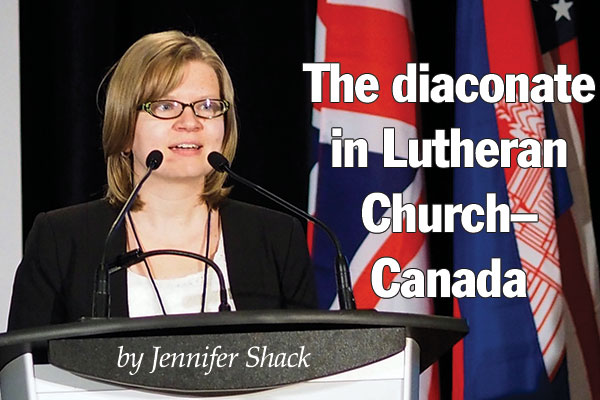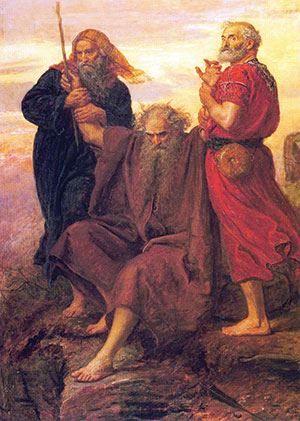The diaconate in Lutheran Church–Canada

Deacon Jennifer Shack presents at Lutheran Church–Canada’s 2014 National Convention in Vancouver. (Photo: Gabor Gasztonyi)
by Jennifer Shack
In 1999 Lutheran Church–Canada (LCC) established something that we call the “office of deacon.” There was a lot of study and thought that went into its establishment and no doubt it was a topic that both pastors and lay-people in our districts had at least heard of during the 1993–1999 convention cycles. Though the topic of the diaconate has been present in some way in each convention since then, what we have not done is continue to educate and inform ourselves of what the deacons of our church are doing nor remind new pastors, delegates and lay-people of the history and care with which this office was established.
Activities of Deacons in Lutheran Church–Canada
It was important for the original Task Force who studied issues of the diaconate in Lutheran Church–Canada in the early 1990s to consider which activities would be appropriate for deacons to participate in because without clarification, confusion might arise. For example, if a specific understanding of what duties a deacon is able to perform is not stated, some deacons may be given duties beyond what is intended for the office, and others may be unnecessarily restricted. Also, unless a proper distinction between deacon and pastor is made, a confusion of roles may result which could lead to power struggles in a congregation and an atmosphere of conflict rather than Christian unity.
LCC teaches that the office of deacon flows out of the office of pastor and is thus under the supervision of the local pastor. Despite this close connection between the offices and the fact that all activities of the deacon may also be carried out by the pastor, deacons may not assume all aspects of the pastoral office. The LCMS CTCR document The Ministry: Offices, Procedures and Nomenclature states:
“Functions that are essentially exercises of the ministry of Word and sacrament should be performed by those who hold the office of the public ministry. Thus, preaching in the worship service, leading in public prayer, celebration of the Sacrament of the Altar, baptisms, wedding and funeral services should be carried out by those who hold the office of public ministry.”
These functions of the pastoral office are not normally open to deacons; however, this same document goes on to note that in certain circumstances, deacons may fulfil some of the duties normally only performed by those in the pastoral office, so long as there are not other reasons why they should not assume such duties.
Apart from these above-mentioned activities which are specific to the office of pastor alone, there are several other functions of the pastoral office which all deacons are eligible to perform. The Task Force, in their document “Scriptural, Dogmatic, and Historical Perspectives,” suggested five areas in which deacons may serve. The first area is described as an “office of love.” The kinds of activities described here encompass various charitable works, social work and healthcare.
A second area where deacons may serve is in pastoral care. In this area, a female deacon might be better suited to serve some of the congregation’s women than would a male pastor, depending on situation and circumstance. This is one of the ways in which the women of the diaconate are invaluable. Under this category, the task force also included the idea of female theologians contributing to scholarly research, writing, and teaching.
The third area of diaconal service is in the area of catechesis. This area is not meant to include instruction through preaching, but rather the work of Lutheran teachers as they teach the Word of God in the classroom. It also may encompass the activities of congregational workers as they teach in various non-preaching capacities within the congregation.
The final two areas where deacons may serve are in church administration and the position of church musician. No qualifications or restrictions are mentioned in the document in relation to these two areas. These five areas of service provide many different avenues by which men and women of various gifts can serve their Lord under the title of “deacon.”
Generally speaking, these recommendations accurately reflect the kind of work carried out by deacons in LCC today. Given the breadth of work that deacons participate in, I think it is safe to say that no two deacons serve in exactly the same capacity anywhere in our church body. Our deacons work long hours alongside pastors and lay-people to do what needs to be done in order to further the gospel in the congregations and schools where they serve.
Images of Deacons

Aaron and Hur hold up Moses’ hands. (John Everett Millais, 1871.)
There are three images of “deacon” which I would like to leave you with. First is the deacon as a delegate of the leader. We see an example of this in Exodus 13:18-26 where Jethro admonishes Moses to appoint men among the people to help him. Moses could not be the only one to whom the Israelites looked to for help and Godly guidance; Moses could not handle the pressure of the task alone. Therefore, Jethro advises him to appoint appropriate helpers so that he does not become overwhelmed with his task. Deacons also serve such a purpose. It is impossible in this day and age for pastors to both teach school and manage a congregation as they once did. They need school and congregational deacons to help them in these tasks.
A second image of deacon is found in Acts 6:1-6. The Seven are appointed here to fulfil a need in the Christian community which the Apostles cannot meet as they are otherwise occupied. The community, on the advice of the Apostles, appoints the Seven to fulfil this need for them. In the same way, deacons today assist in meeting the needs of their congregations and schools which may not otherwise be met. They assist the pastors and congregations in accomplishing the tasks that need to be done.
Finally, Exodus 17:8-13 provides an image of deacon which perhaps embodies the heart of what the diaconate is. Here the Israelites are engaged in battle with the Amalekites. Moses is watching and while his hands are raised, the Israelites are ahead in the battle. As Moses gets tired and can no longer hold up his hands, the Israelites begin to lose the battle. In order to assist, Aaron and Hur bring a stone for Moses to sit on and each of them holds up one of Moses’ hands. Because of their assistance, the Israelites defeat the Amalekites. In the same way, deacons “hold up the hands” of the pastors that they serve with. For a time, the pastor may be able to function alone. After a while, however, when the proverbial battles that are fought daily by pastors for the souls of the lost and for the spiritual health of those for whom they are responsible grow difficult, a deacon can step in to lighten the load and hold up the hands of those with whom they serve so that the Gospel may prevail and the battle may be won.
———————
Deacon Jennifer Shack is pursuing a Ph.D. in biblical studies at McMaster Divinity College in Hamilton, Ontario. She continues to teach part-time at Concordia University College of Alberta from a distance, and was appointed Coordinator of Applied Religion (Church Work) at the college in August 2013. This article is adapted from her presentation to the national convention in Vancouver. For video, powerpoint, and the full-text of the original presentation, click here.





